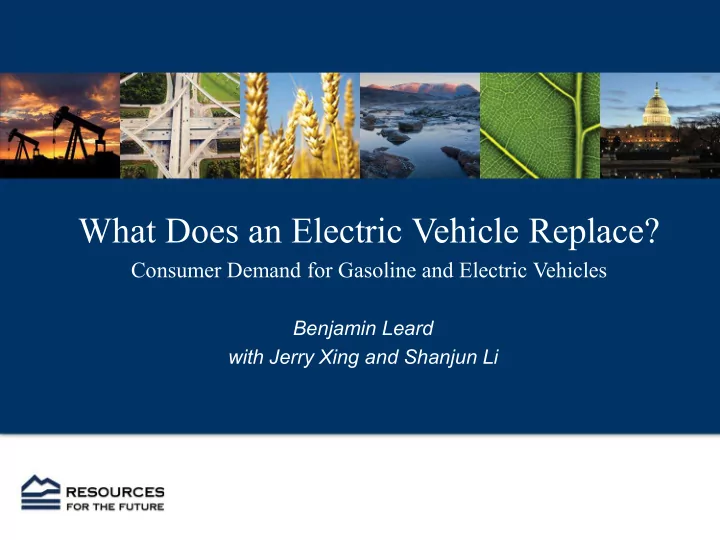

What Does an Electric Vehicle Replace? Consumer Demand for Gasoline and Electric Vehicles Benjamin Leard with Jerry Xing and Shanjun Li
Electric Vehicle Sales September 2019 electric vehicle (EV) sales: ~33,000 out of 1.5 million light- duty sales (2.2% market share) Why is the market share for EVs so small? • EVs have limited driving range. Popular EV options have ~250 miles of range (about ½ of gas options). • They are expensive. 2018 Ford Focus: $17,950 2018 Ford Focus Electric: $29,120 Range: 500 miles Range: 115 miles
Effectiveness of EV Subsidies The U.S. has an EV federal income tax credit of $7,500 to stimulate EV adoption and reduce greenhouse gas emissions (GHGs). GHG emissions reductions from EV adoption = The difference between replacement vehicle emissions and EV emissions Subsidy dollars per ton of emissions reductions depends on which types of vehicles EVs are replacing. 273 grams of CO2/mile saved Ford F150: 423 grams of CO2/mile Tesla Model 3: 21 grams of 150 grams of CO2/mile CO2/mile saved Toyota Prius: 171 grams of CO2/mile
Our Approach We estimate a vehicle choice model using unique household survey data to identify these substitution patterns and to estimate the cost effectiveness of the federal subsidy. MaritzCX Data • 200,000 household per year survey of recent new vehicle buyers, 2012-2014 • Includes “second choice” information on vehicles that buyers considered in addition to the vehicle they purchased • Suggests disproportional substitution from EV to hybrid
Results EVs replace relatively fuel efficient vehicles. • Replacement vehicles have fuel economy that is 4.2 miles per gallon above fleet-wide average. • 12% of replacement vehicles are hybrids (compared to ~3% hybrid market share). The federal tax credit is regressive and is an expensive way to reduce GHG emissions. • The credit increases EV sales by 29%. • Dollars per ton of GHG emissions reductions: $552 • Within the range of recent literature estimates: $340–$650 (Gillingham and Stock 2018) • A much cheaper option in the transport sector is raising the federal gasoline tax ($18–$47 per ton).
Alternative Subsidy Designs Can alternative subsidy designs be more cost effective? • The federal subsidy is the same for all buyers. • California’s Clean Vehicle Rebate Project is a subsidy that varies by household income. • We find that varying the federal subsidy by income, where lower income households are offered a higher subsidy, makes the subsidy progressive and more cost effective. • Dollars per ton of GHG emissions reductions: $484 (about 10% more cost effective than uniform subsidy) • This opens the possibility that further differentiation – such as by vehicle segment (e.g., sedan vs. SUV) – can improve cost effectiveness.
Evolution of the EV market The EV market has changed since our sample period. The Chevrolet Bolt and the Tesla Model 3 have entered the affordable car segment where buyers tend to be more price sensitive than buyers in luxury segments. Sales Increase Cost Per Ton 2014 Benchmark 29% $552 (price elasticity = -2.67) Greater price sensitivity 42% $418 (price elasticity = -4) The $7,500 credit generates more sales as buyers become more price sensitive. The new vehicle market still has few EV options in segments with high- emission vehicles (no pickup truck option). Future expansion of the EV market to affordable SUV and pickup truck segments will increase effectiveness of EV subsidies.
Thank you!
Extra slides Vehicle Gasoline PHEV BEV Market Share Segment Models Models Models (Q4 2018) Convertible 47 0 1 0.5 Coupe 63 0 3 1.6 Hatchback 44 3 7 3.5 Sedan 116 8 4 22.2 Station Wagon 20 0 1 1.4 Pickup Truck 22 0 0 18.2 SUV 122 5 4 49.5 Van 18 1 0 3.1 Total 452 17 20 100
Looking Ahead How will emissions savings from EVs change in the future? • Gasoline vehicles are becoming more fuel efficient as fuel economy standards tighten implies fewer emissions reductions from EV adoption. Source: EPA (2019) • Electricity sector emissions are declining implies more emissions reductions from EV adoption. Source: EIA (2018)
Historical and Projected Electric Vehicle Sales New vehicle sales of electric vehicles (Reference case) millions of vehicles 2018 3 total battery history projections electric Current light-duty 2 Vehicle sales = 17 million Projected sales suggest 300 mile EV hybrid electric we have a long time (20 1 200 mile EV years) before electric vehicles (EVs) get 10% market share. plug-in hybrid 100 mile EV 0 2010 2020 2030 2040 2050 Source: AEO (2019) 12
Historical and Projected GHG Emissions Carbon dioxide intensity by end-use sector Carbon dioxide intensity by end-use sector (Reference case) (Reference case) metric tons of carbon dioxide per billion British metric tons of carbon dioxide per billion British 2018 thermal units thermal units 2018 75 history projections history projections 70 transportation 65 60 commercial 55 residential 50 45 industrial 40 The electric power sector is redistributed electric power to each end-use sector 35 1990 2000 2010 2020 2030 2040 2050 1990 2000 2010 2020 2030 2040 2050 Source: AEO (2019) 13
Recommend
More recommend